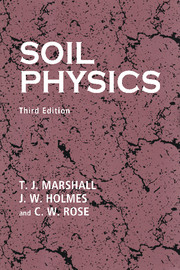Book contents
- Frontmatter
- Contents
- Preface
- Preface to the second edition
- Preface to the first edition
- 1 Composition of soil
- 2 Interaction of soil and water
- 3 Measurement of water content and potential
- 4 Principles of water movement in soil
- 5 Distribution of water in soil
- 6 Ground water in soils and aquifers
- 7 The use of isotopes and other tracers in soil water and groundwater studies
- 8 Soil structure
- 9 Deformation of soil
- 10 Management of soil water
- 11 Soil erosion and conservation
- 12 Chemical transport in soil
- 13 The physical environment of roots
- 14 Plants and soil water
- Appendixes
- References
- Index
6 - Ground water in soils and aquifers
Published online by Cambridge University Press: 05 June 2012
- Frontmatter
- Contents
- Preface
- Preface to the second edition
- Preface to the first edition
- 1 Composition of soil
- 2 Interaction of soil and water
- 3 Measurement of water content and potential
- 4 Principles of water movement in soil
- 5 Distribution of water in soil
- 6 Ground water in soils and aquifers
- 7 The use of isotopes and other tracers in soil water and groundwater studies
- 8 Soil structure
- 9 Deformation of soil
- 10 Management of soil water
- 11 Soil erosion and conservation
- 12 Chemical transport in soil
- 13 The physical environment of roots
- 14 Plants and soil water
- Appendixes
- References
- Index
Summary
The movement of water through soil has been intensively studied in the laboratory, particularly with respect to flow under unsaturated conditions. These experiments and their results, which have been described in Chapters 4 and 5, have provided confirmation of the present understanding of the theory of water flow through soils. The scale of such experiments has, of necessity, been limited. Controlled experimentation of the field size has generally been daunting, principally because it has appeared that the financial cost could not be justified. Childs (1953) and his co-workers established a full-scale field drainage laboratory near Cambridge, in which numerous three-dimensional problems have been investigated by direct experiment. Their drainage tank was about 10 m by 10 m in horizontal dimensions and was filled with a sand of homogeneous and isotropic properties. Application of the results from this installation and others (for example, van Schilfgaarde, Frevert, and Kirkham, 1954) was intended to provide design data for improving the economy and efficiency of artificial field drainage, the principles concerning which we now proceed to describe.
Artificial drainage
In low-lying coastal regions the water table can be found close to the soil surface at an elevation a little above sea level. The hydraulic potential of the reservoir, or sink, to which the flow of the groundwater must be directed is the level of the sea or its tidal inlets. Alluvial plains, reclaimed deltas, and their swampy margins have often needed artificial drainage to improve agricultural or pastoral production.
- Type
- Chapter
- Information
- Soil Physics , pp. 140 - 171Publisher: Cambridge University PressPrint publication year: 1996



